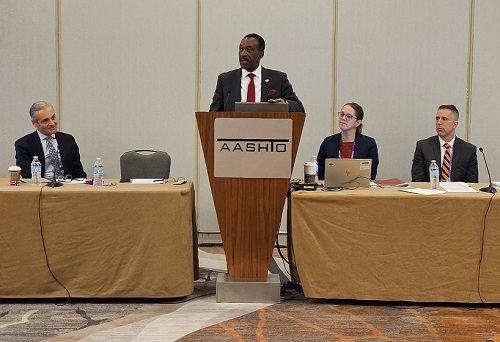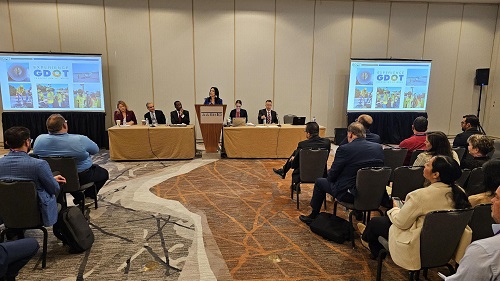A knowledge session held at the American Association of State Highway and Transportation Officials 2023 Annual Meeting addressed current and future workforce recruitment and retention issues.
[Above photo by AASHTO]
“This is a gargantuan problem, but we have to talk about it in terms of what we can control regarding attracting and retaining workers,” explained Jack Marchbanks, director of the Ohio Department of Transportation, at the session.

He said the Ohio DOT is particularly focused on reaching young people – particularly middle school students – through a variety of initiatives, such as youth environmental transportation camps and construction career days.
“We are getting a huge amount of young people to come out to these events,” Marchbanks said, noting that his agency’s most recent Construction Career Day attracted 3,098 middle school participants. “We believe these efforts to seize interest in transportation infrastructure will bear fruit,” he stressed.
Marchbanks noted those actions are occurring alongside Ohio DOT efforts to work with “community action agencies” to recruit and prepare formerly incarcerated individuals for transportation jobs, as well as offer college scholarship opportunities and internships, too.
“This is a fascinating and challenging business we are in – we touch every facet of modern life,” Marchbanks noted. The inherent “meaningfulness” of that work, he stressed, is what will help “attract more young people” to the industry.

Jeff Pelton, assistant secretary-finance and administrative services for the Washington State Department of Transportation made a similar point, stressing that making younger workers feel like they “belong” to a company, be it in the private or public sector, is crucial.
“When employees feel like they belong in a workplace, it can increase retention rates,” he said. “We really need to be focused on the cultural aspects of attracting and keeping them in our workforce. That means concentrating on employee engagement; the modern work environment, where year-to-date an average of 43 percent of the WSDOT workforce teleworked; and developing talent. We really have to sell our culture and our flexibility as a state DOT.”
Shannon Peloquin – a partner with consulting firm McKinsey & Co. who served as the session’s moderator – noted that the “structural headwinds” facing the construction labor market are only growing more acute.

“There is a supply/demand labor gap in the construction industry along with other structural headwinds such as inflation and stagnant project delivery models that have not changed in 30 years,” she said.
Peloquin added that 41 percent of the current construction workforce is expected to retire by 2031, which will put further pressure on the sector’s labor needs.
Brian Turmail, vice president of public affairs and strategic initiatives for the Associated General Contractors of America, pointed out that filling in behind those retirements has become more difficult due to what he called “higher educational bias” whereby federal fiscal support is geared more to college education rather than vocational careers.
“The federal government spends 20 cents on career technical education for every $1 on college programs,” he explained. “We have a lot of people today who don’t realize these careers [in construction] even exist.”
Turmail echoed the cultural themes espoused by WSDOT’s Pelton, noting that his organization has created a “culture of care” curriculum to help contractors make construction job sites more welcoming and supportive. “We must create a more welcoming place at the construction job site for every generation wants to feel more part of the team,” he said.

That’s also why more and varied internal training programs for new engineers are needed, added Sue Anne Decker, assistant director of strategic and systems planning for the Georgia Department of Transportation.
“Once you get into the Georgia DOT, the focus turns to continuing education,” she explained. “There is an internal rotation of new engineering hires so we can show them everything our agency does. They get out on job sites, work with operations, and get into planning work; and that cross training allows them to apply for more open positions within our agency.”
That’s part of why Lindsay Shelton Gross – vice president external relations and strategic initiatives for WTS International – called for adding “belonging and accessibility” to the diversity, equity, and inclusion or DEI protocols in the construction and transportation industries.
“The workforce is out there – we just need to reach them, especially through the issues they are very invested in,” she said. “It’s about bringing the jobs to the people and accommodating multi-generations in the workforce.”
 Nation
Nation
Registration Open for AASHTO’s Winter Rail Meeting
December 19, 2025 Nation
Nation

